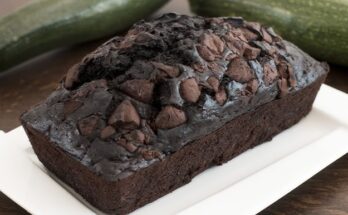Tapioca Pudding Recipe: There’s something heartwarming about a creamy bowl of tapioca pudding. It’s nostalgic, comforting, and surprisingly easy to make from scratch. Whether you’re reliving your childhood or introducing this old-school dessert to someone new, this step-by-step guide will help you master the perfect tapioca pudding—one spoonful at a time.
Introduction to Tapioca Puddin
So, what exactly is tapioca pudding? It’s a classic dessert made from tapioca pearls (small balls processed from cassava root), milk, sugar, and often eggs for richness. The result is a lusciously creamy texture with chewy pearls suspended throughout. Think of it like a more elegant version of rice pudding—with a little bounce.
Tapioca pudding has roots in various cultures, especially in South America and Southeast Asia. Over time, it has become a beloved comfort food in the U.S., especially for those who grew up with it in their lunchboxes or as a warm dessert after dinner.
What makes it so special? Its texture. The pearls add a unique mouthfeel that’s both fun and satisfying. Plus, it’s naturally gluten-free, making it a go-to option for those with dietary restrictions. Whether served warm with a cinnamon sprinkle or chilled with a dollop of whipped cream, tapioca pudding delivers a cozy culinary hug every time.
Ingredients You’ll Need
Before we get into the nitty-gritty of cooking, let’s round up the ingredients. The key to a delicious tapioca pudding is balance—creamy, sweet, and just a hint of vanilla.
Basic Ingredients:
- Tapioca pearls – 1/2 cup (small pearl variety)
- Milk – 2 1/2 cups (whole milk is best for creaminess)
- Water – 1 1/2 cups (for soaking/cooking pearls)
- Sugar – 1/3 cup (adjust to taste)
- Salt – a pinch
- Eggs – 2 large (adds richness)
- Vanilla extract – 1 tsp
Optional Add-ins:
- Coconut milk – swap out part of the milk for tropical flavor
- Spices – cinnamon, nutmeg, or cardamom
- Fruit toppings – berries, banana slices, or mango
Substitution Tips:
- For a vegan version, use plant-based milk (almond, soy, or oat) and skip the eggs, thickening with a little cornstarch if needed.
- If you’re avoiding refined sugar, maple syrup or honey can be used, though the texture might shift slightly.
The star here is the tapioca itself. Small pearls work best for classic pudding—avoid instant or large pearls unless you want to experiment with texture. Read the label carefully, as some brands require pre-soaking while others don’t.
Kitchen Tools Required
Let’s make sure you have the right tools before we dive into the process. The good news? You don’t need anything fancy.
Essential Tools:
- Medium saucepan – For simmering your tapioca
- Mixing bowls – For beating eggs and tempering
- Whisk or spoon – To stir constantly and prevent clumping
- Measuring cups and spoons – Accuracy matters
- Ladle or spoon – For serving
Optional (But Handy) Tools:
- Fine mesh strainer – If you need to drain soaked pearls
- Thermometer – For precise heating (especially useful when tempering eggs)
- Rubber spatula – Helps scrape the bottom and sides while cooking
Having everything set up beforehand (yes, like a mini cooking show) will save time and stress, especially once you start tempering the eggs—which is a crucial step you don’t want to mess up.
Prepping Your Tapioca Pearls
This step depends on the kind of tapioca you have. Some brands sell “quick-cooking” pearls, which don’t require soaking, but if you’ve got traditional small pearls, soaking is a must.
Soaking Instructions:
- Measure your tapioca pearls into a bowl.
- Cover with cold water (about 2 inches above the pearls).
- Let soak for 30 minutes to 1 hour.
- Drain in a fine mesh sieve before cooking.
Soaking helps the pearls hydrate and shortens cooking time, while ensuring they cook evenly without turning to mush. You’re looking for plump but firm pearls—not hard in the center, but not falling apart either.
If you skip this step, you might end up with gummy or uneven results, which nobody wants. Trust the process—it’s worth the extra half hour.
Cooking Tapioca Pudding – Step-by-Step
Alright, aprons on! Let’s walk through the full cooking process. This part might seem tricky the first time, especially the egg-tempering bit, but once you’ve done it, you’ll realize how simple and satisfying it really is.
Step 1: Simmer the Tapioca
In a medium saucepan, combine the soaked tapioca with water and a pinch of salt. Bring it to a gentle boil over medium heat, then reduce to a simmer. Cook until the pearls turn translucent—about 10-15 minutes, stirring often to prevent sticking.
Step 2: Mix in the Milk
Once the tapioca pearls are mostly translucent, add in the milk. Stir to combine and bring the mixture back to a gentle simmer. This is where it starts to get creamy and dreamy.
Step 3: Temper the Eggs
Crack your eggs into a bowl and beat them lightly. Now here’s the crucial step—take a ladle of hot tapioca mixture and slowly pour it into the eggs while whisking constantly. This prevents the eggs from scrambling. Repeat with another ladle, then pour the tempered eggs back into the pot.
Step 4: Sweeten and Thicken
Add sugar to the pot and stir it in well. Continue cooking over low heat, stirring constantly. The pudding will start to thicken after about 5-7 minutes. Don’t rush this—if the heat’s too high, you risk curdling the eggs.
Step 5: Final Simmer and Check Consistency
When the pudding is thick enough to coat the back of a spoon, remove it from heat. Stir in vanilla extract and any optional spices. Let it cool slightly before serving, or chill it for a few hours if you prefer it cold.
Serving Suggestions for Tapioca Pudding
You’ve done the hard part—now it’s time to enjoy your creation! Tapioca pudding is delicious on its own, but the way you serve it can totally elevate the experience. Whether you’re going for classic comfort or something a little more adventurous, there are plenty of options to play with.
Classic Style:
Serve it warm in a small bowl with a sprinkle of cinnamon or nutmeg on top. This is the cozy, grandma-approved way to enjoy it, especially on chilly evenings. A pat of butter on top? It melts right in and adds extra richness.
Chilled and Topped:
Prefer it cold? Let your pudding cool and then refrigerate it for a few hours. Serve it with a dollop of whipped cream and maybe a few fresh berries or banana slices. It transforms into a light, refreshing dessert that’s perfect for summer days.
Layered Parfait:
If you’re hosting guests or just want to make your pudding Instagram-worthy, go for a layered parfait. Spoon your pudding into a glass, alternate with layers of fruit compote or crushed cookies, and top with whipped cream or toasted coconut. Gorgeous and delicious!
Flavor Enhancers:
- Add a drizzle of honey or caramel sauce
- Top with chopped nuts like pistachios or almonds for crunch
- Add a few shavings of dark chocolate or a dusting of cocoa powder
No matter how you serve it, tapioca pudding adapts to your cravings—whether you want rustic simplicity or restaurant-level presentation.
Storage and Shelf Life Tips
So you’ve made a big batch of pudding—what now? Good news: tapioca pudding stores really well, and it’s perfect for meal prep or make-ahead desserts.
Refrigerator Storage:
Place leftover pudding in an airtight container or cover the bowl tightly with plastic wrap. It will keep in the fridge for up to 5 days. Just be sure to give it a good stir before serving again, as it may thicken slightly or form a thin skin on top (especially if you didn’t cover it tightly).
If you prefer your pudding warm, simply reheat it gently in the microwave or over low heat on the stove. You might need to add a splash of milk to loosen it up, as tapioca tends to absorb liquid even after it’s cooked.
Freezing Notes:
While it’s possible to freeze tapioca pudding, it’s not ideal. Freezing can mess with the texture of the pearls and make the pudding watery or rubbery when thawed. If you do freeze it, wrap tightly and eat within 2–3 weeks, reheating gently while stirring constantly.
Quick Storage Tips:
- Use single-serving containers for grab-and-go snacks.
- Label with the date so you know when to use it by.
- Keep refrigerated at all times—especially if using eggs.
Troubleshooting Common Mistakes
Even seasoned cooks run into a few hiccups when making tapioca pudding. Here are some common issues and how to fix (or avoid) them:
1. Pudding is Too Runny
If your pudding hasn’t thickened, it could be due to undercooked tapioca or not enough simmering time after adding the eggs. Let it cook longer on low heat, stirring constantly. Be patient—it thickens up more as it cools, too.
2. Eggs Curled (Scrambled!)
Uh-oh—this usually means the eggs weren’t tempered properly. Make sure to add hot tapioca to the eggs very slowly while whisking constantly. If you still end up with curdled bits, you can strain the pudding through a sieve to salvage it.
3. Tapioca Pearls Are Still Crunchy
This usually means they weren’t soaked or cooked long enough. If the pearls haven’t softened, continue cooking them in the milk until they become fully translucent. Stir often and lower the heat if needed to prevent scorching.
4. Too Sweet or Not Sweet Enough
Everyone’s taste buds are different, so feel free to adjust the sugar. Always taste your pudding before removing it from the heat, and tweak it with a touch of extra sugar, honey, or even a splash of vanilla extract to round out the flavor.
Health Benefits of Tapioca Pudding
It may be a dessert, but tapioca pudding actually comes with some surprising nutritional benefits—especially if you tweak the ingredients a bit.
Gluten-Free Goodness:
Tapioca is naturally gluten-free, making it an excellent dessert option for those with celiac disease or gluten sensitivity. No need for specialty flours or expensive substitutes—just simple ingredients that work.
Energy Boost:
Tapioca is primarily made of carbohydrates, which are the body’s main source of energy. It’s not low-carb, but it’s great for fueling up before a workout or getting through an afternoon slump.
Gentle on the Stomach:
Thanks to its smooth texture and easily digestible nature, tapioca pudding is often recommended for people recovering from illness or with sensitive stomachs. It’s light, filling, and won’t weigh you down.
Customizable for Health:
Want to make it healthier? Here are a few tips:
- Use almond or oat milk for fewer calories
- Swap sugar with natural sweeteners like maple syrup
- Add fruit or fiber-rich toppings for extra nutrition
While it’s still a treat, with a few smart swaps, you can enjoy tapioca pudding guilt-free—and even sneak in a few health benefits while you’re at it.
Tapioca Pudding Around the World
Tapioca may be most familiar to you as a dessert from American kitchens, but it has a global history. Across continents, tapioca is used in wildly different and delicious ways.
Brazil:
The birthplace of tapioca (thanks to the cassava root), Brazil serves tapioca in many forms. One popular treat is “tapioca crepes” made from hydrated tapioca flour, but you’ll also find sweet puddings, often flavored with coconut and spices.
Southeast Asia:
In countries like Thailand, Malaysia, and Indonesia, tapioca pudding is often made with coconut milk, pandan leaves, and topped with tropical fruits like mango, banana, or jackfruit. The pearls are sometimes dyed in bright colors to make the dessert even more appealing.
India:
Sabudana, the Indian version of tapioca, is used during religious fasts. Sabudana kheer is a creamy pudding made with milk, sugar, and cardamom, and is a staple during Hindu festivals.
Caribbean:
In the Caribbean islands, tapioca is blended with spices like nutmeg and cinnamon, and enriched with condensed milk for a luxuriously rich pudding.
Tapioca truly transcends borders—it’s a dessert of comfort, connection, and culture.
Tapioca Pudding for Special Diets
Got dietary restrictions? No problem. Tapioca pudding is incredibly versatile and can be tweaked to suit almost any dietary preference or requirement without sacrificing flavor or texture. Whether you’re vegan, dairy-free, low-sugar, or keto-conscious, you can still indulge in this creamy delight.
Vegan Tapioca Pudding
To make it completely plant-based, skip the eggs and use a non-dairy milk such as:
- Almond milk (light and nutty)
- Coconut milk (rich and tropical)
- Oat milk (creamy and neutral)
Instead of using eggs to thicken the pudding, try:
- 1 tablespoon of cornstarch mixed with water
- 2 tablespoons of blended silken tofu
- A bit more simmering time to naturally thicken with tapioca alone
Sweeten with maple syrup, agave nectar, or coconut sugar to keep it vegan and flavorful.
Low-Sugar or Diabetic-Friendly
You can still enjoy the creamy texture without overloading on sugar. Use:
- Stevia or monk fruit sweetener (in small amounts)
- Erythritol or xylitol for a more traditional sweet flavor
- Cinnamon or vanilla to enhance natural sweetness
Keep an eye on portion sizes, and always taste before adding more sweetener.
Dairy-Free Version
If lactose is your enemy, swap out regular milk for plant-based alternatives or even lactose-free cow’s milk. Coconut milk and almond milk work beautifully and still create a rich, velvety pudding.
With a few thoughtful tweaks, this traditional dessert becomes a go-to comfort food for just about everyone.
How to Make Tapioca Pudding in a Slow Cooker
If you love the idea of “set it and forget it,” using a slow cooker to make tapioca pudding might be your new favorite method. It’s simple, hands-off, and perfect for making big batches without standing over the stove.
Ingredients:
- 1/2 cup small tapioca pearls
- 3 cups milk (or plant-based)
- 2 large eggs (optional)
- 1/3 cup sugar
- 1 tsp vanilla
- A pinch of salt
Steps:
- Spray the inside of your slow cooker with non-stick spray or lightly grease it.
- Combine all ingredients in the cooker and stir well.
- Set to low heat and cook for 2 to 3 hours, stirring occasionally.
- Once the pearls are translucent and the pudding has thickened, turn off the heat.
- Let it rest for 15-20 minutes—it thickens more as it cools.
- Serve warm or chilled with your favorite toppings.
Tips:
- Stir once every 30–45 minutes to prevent sticking.
- Don’t overcook—it can turn gummy.
- Add a splash of extra milk if it gets too thick.
This method is perfect if you’re multitasking, entertaining, or just love coming home to a ready-to-eat dessert.
Creative Flavor Twists for Your Pudding
Want to jazz up your pudding and move beyond the vanilla default? There are tons of flavor combos to experiment with that will keep your taste buds excited. Here are some creative and easy variations:
Chocolate Tapioca Pudding
- Add 2 tablespoons of unsweetened cocoa powder during cooking.
- Mix in chocolate chips at the end for gooey pockets of chocolatey goodness.
Matcha Green Tea
- Add 1 teaspoon of matcha powder to your milk mixture.
- Sweeten with honey and top with mochi or toasted coconut for an Asian fusion dessert.
Pumpkin Spice
- Stir in 1/4 cup pumpkin puree and 1/2 tsp pumpkin pie spice.
- A fall favorite that tastes like a hug in a bowl.
Lemon Coconut
- Add 1 tsp lemon zest and use half coconut milk.
- Top with toasted coconut flakes and a dollop of whipped cream.
Don’t be afraid to get creative—it’s still the same creamy comfort, just with a twist that keeps it fresh.
Kids’ Favorite Tapioca Pudding Variations
Tapioca pudding isn’t just for grown-up nostalgia—it’s a total hit with kids too! The texture, sweetness, and fun add-ins make it easy to adapt for even the pickiest little eaters.
Rainbow Tapioca
Use naturally colored tapioca pearls or dye the milk mixture with food coloring. Layer different colors in cups for a fun surprise.
Cookie Crumble Topping
Add crushed cookies (Oreos, graham crackers, or vanilla wafers) as a crunchy topping.
Fruity Fun
Mix in mashed bananas, strawberry puree, or mango chunks. It adds color, natural sweetness, and boosts nutrition.
Serve with a Spoon of Jam
Swirl in a spoonful of their favorite jam or jelly to add flavor and fun.
Want to sneak in some nutrition? Use full-fat milk or calcium-fortified plant milk, and top it with berries or chia seeds. They’ll love it, and you’ll feel good serving it.
FAQs about Tapioca Pudding Recipe
What is tapioca pudding?
Tapioca pudding is a creamy dessert made from tapioca pearls, which are derived from the cassava root. It combines milk or cream, sugar, and sometimes eggs to create a sweet and slightly chewy treat.
How do I make tapioca pudding from scratch?
To make tapioca pudding, you’ll need to soak small tapioca pearls in water for about 30 minutes. Drain and mix the pearls with milk, sugar, and a pinch of salt, and cook over medium heat until the pearls become translucent and the mixture thickens. For a richer flavor, add a beaten egg and vanilla extract towards the end of cooking, stirring continuously to avoid curdling.
Can I use instant tapioca instead of pearls?
Yes, instant tapioca can be used as a quicker alternative to traditional tapioca pearls. The cooking time will be significantly reduced, so follow the package instructions for best results.
Is tapioca pudding gluten-free?
Yes, tapioca pudding is naturally gluten-free as tapioca pearls are made from cassava, which does not contain gluten. However, always check the labels of other ingredients to ensure they do not contain gluten additives.
How long does homemade tapioca pudding last in the fridge?
Homemade tapioca pudding can be stored in the refrigerator in an airtight container for up to 5 days. Make sure it cools to room temperature before refrigerating to maintain the best quality.
Can tapioca pudding be frozen?
It is possible to freeze tapioca pudding, though the texture may change slightly upon thawing. For best results, freeze in a covered airtight container or heavy-duty freezer bag.
Are there any variations to traditional tapioca pudding?
Absolutely! You can flavor your tapioca pudding with different extracts like almond or coconut, mix in fruits like mango or banana, or even add spices such as cinnamon or nutmeg for a unique twist.
Conclusion
It’s easy to make, customizable for every diet, and perfect for any season. You can serve it hot on a rainy day or chilled at a summer picnic. It’s just one of those “always good” kind of desserts.
If you’ve never made tapioca pudding before, now’s the time to give it a go. This step-by-step guide walks you through every moment of the process so you can whip up a batch with confidence and maybe even a little pride.
Trust me—you’ll be back for seconds.



